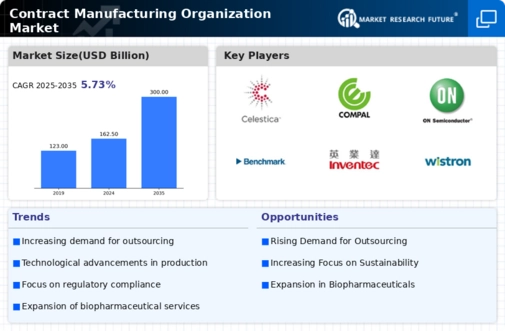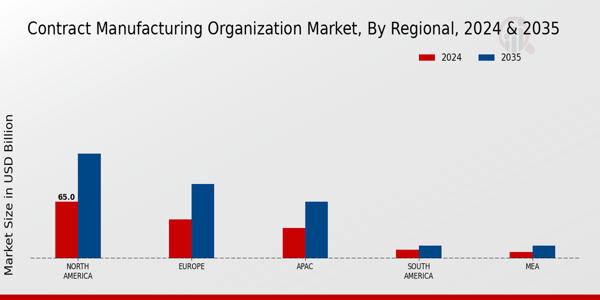Market Growth Projections
The Global Contract Manufacturing Organization Market Industry is poised for substantial growth, with projections indicating a rise from 162.5 USD Billion in 2024 to 300 USD Billion by 2035. This trajectory suggests a compound annual growth rate of 5.73% from 2025 to 2035, reflecting the increasing reliance on contract manufacturing across various sectors. Factors such as technological advancements, globalization of supply chains, and heightened demand for quality assurance are likely to contribute to this growth. The market's expansion underscores the evolving landscape of manufacturing, where companies are increasingly turning to specialized partners to meet their production needs.
Globalization of Supply Chains
The globalization of supply chains is a critical driver in the Global Contract Manufacturing Organization Market Industry. As companies expand their operations internationally, they seek contract manufacturers that can provide localized production capabilities. This trend is particularly pronounced in sectors such as electronics and consumer goods, where proximity to markets can significantly reduce shipping costs and lead times. By leveraging global networks, businesses can optimize their supply chains, enhance responsiveness to market demands, and improve overall efficiency. This strategic approach is likely to contribute to the market's growth trajectory, aligning with the projected figures for the coming years.
Increased Focus on Sustainability
Sustainability is becoming an increasingly important consideration within the Global Contract Manufacturing Organization Market Industry. Companies are under pressure to adopt environmentally friendly practices and reduce their carbon footprints. This shift is prompting contract manufacturers to implement sustainable production methods, such as waste reduction and energy efficiency initiatives. As consumers become more environmentally conscious, businesses that prioritize sustainability are likely to enhance their brand reputation and customer loyalty. This growing emphasis on sustainable practices may also influence investment decisions and partnerships, further driving the market's evolution.
Rising Demand for Outsourced Manufacturing
The Global Contract Manufacturing Organization Market Industry is experiencing a notable increase in demand for outsourced manufacturing services. Companies are increasingly recognizing the benefits of outsourcing, such as cost reduction and access to specialized expertise. This trend is particularly evident in the pharmaceutical sector, where the need for efficient production processes is paramount. As a result, the market is projected to reach 162.5 USD Billion in 2024, with a compound annual growth rate of 5.73% anticipated from 2025 to 2035. This growth reflects a broader shift towards leveraging external capabilities to enhance operational efficiency and focus on core competencies.
Regulatory Compliance and Quality Assurance
The Global Contract Manufacturing Organization Market Industry is heavily influenced by the need for stringent regulatory compliance and quality assurance. As industries such as pharmaceuticals and biotechnology face increasing scrutiny from regulatory bodies, the demand for contract manufacturers that adhere to high standards is rising. Companies are seeking partners that can demonstrate robust quality management systems and compliance with Good Manufacturing Practices. This focus on quality not only mitigates risks but also enhances product reliability, thereby fostering trust among consumers. Consequently, this driver is pivotal in shaping partnerships and influencing market dynamics.
Technological Advancements in Manufacturing
Technological innovations are significantly shaping the Global Contract Manufacturing Organization Market Industry. The integration of automation, artificial intelligence, and advanced manufacturing technologies is enhancing production efficiency and quality. For instance, the adoption of robotics in assembly lines has streamlined operations, reducing lead times and minimizing errors. These advancements not only improve productivity but also enable manufacturers to meet stringent regulatory requirements. As the industry evolves, companies that embrace these technologies are likely to gain a competitive edge, further driving the market's expansion towards an estimated 300 USD Billion by 2035.
















